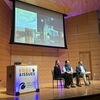Processing Your Payment
Please do not leave this page until complete. This can take a few moments.
- News
-
Editions
View Digital Editions
Biweekly Issues
- December 1, 2025
- Nov. 17, 2025
- November 03, 2025
- October 20, 2025
- October 6, 2025
- September 22, 2025
- + More
Special Editions
- Lists
- Viewpoints
-
Our Events
Event Info
Award Honorees
- Calendar
- Biz Marketplace
The measure of a man | The story behind America's refusal to convert
Roland from Lewiston writes: “John, I’ve just returned from another delightful trip to visit relatives and friends in Canada. Every time I visit our neighbors to the north I am reminded once again that America is one of the few countries in the civilized, or even the uncivilized, world that still refuses to adapt to the metric system. What is it with us Americans and our fascination with things like the mile and the pint and the foot and the quart?”
It’s funny that you mention our fascination with the mile and the quart because whenever I drive by one of those mileage signs on the turnpike that give the distance to an exit in miles and kilometers, and every time I reach for a half-gallon of milk in the cooler at the grocery store, I feel kind of proud that America remains unique among all the nations of the world.
I know, Roland, that to the casual observer — or even the formal onlooker — our mile seems pretty arbitrary. Why 5,280 feet? Why didn’t they at least round it up to 5,300? When you look into the word “mile” and its origin, however, things become a little clearer. The word started off with some relationship to that metric system you seem so fond of, Roland. Mile comes from the Latin word “mille,” which means one thousand. Your beloved kilometer comes from a Greek word that means the same thing. So, you see, the two systems start off with at least that much in common.
Long ago and far away, when they were just beginning to build what would eventually become a vast, sprawling empire, the Romans wanted a standard unit of measure to keep track of how far places were from each other as they went about conquering one place after another. After what we can only assume was a lengthy and heated department-head meeting, they settled on something they called the mille, or the distance a Roman foot soldier could cover in one thousand paces. Turns out it was 5,000 feet. I know it sounds like a stretch to say that someone — even a foot soldier — could go 5,000 feet in 1,000 paces, but that’s what the Romans claimed, and it’s too late to argue the point now.
Anyway, for hundreds of years, everyone agreed that the mille was 5,000 feet. Trouble started brewing when the Romans introduced their popular mille to their newly conquered province of Briton. The Brits let the Romans know right off that they already had an equally popular standard of measure, thank you very much. The Brits used something called the furlong, and they were in no mood to change just because the Romans had come along and conquered their lush, green island.
The well-liked furlong had been used in Briton to measure things like the length of a farmer’s field. The word came from two fine Old English words — “furrow” and “length” — and a furlong measured 660 feet. In fact it still does, but now it’s mostly used at racetracks.
As often happens in the course of human events, the two units — the mille and the furlong — were blended together, and when all the dust had settled, it was decided that the mille, which eventually had an ‘l’ knocked out of it and became known as the mile, would represent the distance of eight furlongs. Do the math, Roland, and you will discover that eight furlongs comes out to our seemingly arbitrary 5,280 feet.
The whole business with the nautical mile, however — which I suspect isn’t used all that much in the Lewiston-Auburn area — is quite different. First off, the nautical mile has nothing to do with either the paces of Roman foot soldiers or the contrary nature of Brit farmers, so it’s not surprising to learn that the nautical mile is not 5,280 feet.
Only at sea is the mile 6,080 feet, or 1.15 land miles. But even here, Roland, the nautical mile has a metric history. Originally, the nautical mile was supposed to be 1,000 fathoms. For landlubbers in the audience, a fathom is six feet and represented the length of a sailor’s outstretched arms. Once again, if you do the math, you might conclude that a nautical mile should be 6,000 feet, but an old salt would say, “Not so fast, barnacle breath.” So, how did the nautical mile grow 80 feet? It could be that the outstretched sailor they used to establish the length of a fathom had a longer reach than he should have. Who knows?
I hope this information helps you, Roland, on your next trip to visit relatives in Canada, or your next trip sailing along the coast.
John McDonald, an author, humorist and storyteller who performs throughout New England, can be reached at mainestoryteller@yahoo.com. Read more of John’s columns at www.mainebiz.biz.
Mainebiz web partners

The Giving Guide
The Giving Guide helps nonprofits have the opportunity to showcase and differentiate their organizations so that businesses better understand how they can contribute to a nonprofit’s mission and work.
Learn More
Work for ME
Work for ME is a workforce development tool to help Maine’s employers target Maine’s emerging workforce. Work for ME highlights each industry, its impact on Maine’s economy, the jobs available to entry-level workers, the training and education needed to get a career started.
Learn More
Groundbreaking Maine
Whether you’re a developer, financer, architect, or industry enthusiast, Groundbreaking Maine is crafted to be your go-to source for valuable insights in Maine’s real estate and construction community.
Learn more-
The Giving Guide
The Giving Guide helps nonprofits have the opportunity to showcase and differentiate their organizations so that businesses better understand how they can contribute to a nonprofit’s mission and work.
-
Work for ME
Work for ME is a workforce development tool to help Maine’s employers target Maine’s emerging workforce. Work for ME highlights each industry, its impact on Maine’s economy, the jobs available to entry-level workers, the training and education needed to get a career started.
-
Groundbreaking Maine
Whether you’re a developer, financer, architect, or industry enthusiast, Groundbreaking Maine is crafted to be your go-to source for valuable insights in Maine’s real estate and construction community.
ABOUT
NEW ENGLAND BUSINESS MEDIA SITES
No articles left
Get access now
In order to use this feature, we need some information from you. You can also login or register for a free account.
By clicking submit you are agreeing to our cookie usage and Privacy Policy
Already have an account? Login
Already have an account? Login
Want to create an account? Register
Get access now
In order to use this feature, we need some information from you. You can also login or register for a free account.
By clicking submit you are agreeing to our cookie usage and Privacy Policy
Already have an account? Login
Already have an account? Login
Want to create an account? Register







Comments